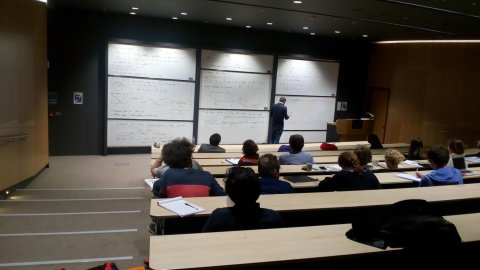14:30
Optimal Resistor Networks
Abstract
Suppose we have a finite graph. We can view this as a resistor network where each edge has unit resistance. We can then calculate the resistance between any two vertices and ask questions like `which graph with $n$ vertices and $m$ edges minimises the average resistance between pairs of vertices?' There is a `obvious' solution; we show that this answer is not correct.
This problem was motivated by some questions about the design of statistical experiments (and has some surprising applications in chemistry) but this talk will not assume any statistical knowledge.
This is joint work with Robert Johnson.
Self-maps on compact F-spaces.
Abstract
Compact F-spaces play an important role in the area of compactification theory, the prototype being w*, the Stone-Cech remainder of the integers. Two curious topological characteristics of compact F-spaces are that they don’t contain convergent sequences (apart from the constant ones), and moreover, that they often contain points that don’t lie in the boundary of any countable subset (so-called weak P-points). In this talk we investigate the space of self-maps S(X) on compact zero-dimensional F-spaces X, endowed with the compact-open topology. A natural question is whether S(X) reflects properties of the ground space X. Our main result is that for zero-dimensional compact F-spaces X, also S(X) doesn’t contain convergent sequences. If time permits, I will also comment on the existence of weak P-points in S(X). This is joint work with Richard Lupton.
Renormalisation and the Euler-Maclaurin formula on cones
Abstract
[based on joint work with Li Guo and Bin Zhang]
We apply to the study of exponential sums on lattice points in
convex rational polyhedral cones, the generalised algebraic approach of
Connes and Kreimer to perturbative quantum field theory. For this purpose
we equip the space of cones with a connected coalgebra structure.
The algebraic Birkhoff factorisation of Connes and Kreimer adapted and
generalised to this context then gives rise to a convolution factorisation
of exponential sums on lattice points in cones. We show that this
factorisation coincides with the classical Euler-Maclaurin formula
generalised to convex rational polyhedral cones by Berline and Vergne by
means of an interpolating holomorphic function.
We define renormalised conical zeta values at non-positive integers as the
Taylor coefficients at zero of the interpolating holomorphic function. When
restricted to Chen cones, this yields yet another way to renormalise
multiple zeta values at non-positive integers.
17:30
Social Capital and Microfinance
Abstract
A hybrid numerical-asymptotic boundary element method for scattering by penetrable obstacles
Abstract
When high-frequency acoustic or electromagnetic waves are incident upon an obstacle, the resulting scattered field is composed of rapidly oscillating waves. Conventional numerical methods for such problems use piecewise-polynomial approximation spaces which are not well-suited to capture the oscillatory solution. Hence these methods are prohibitively expensive in the high-frequency regime. Much work has been done in developing “hybrid numerical-asymptotic” (HNA) boundary element methods which utilise approximation spaces containing oscillatory functions carefully chosen to capture the high-frequency asymptotic behaviour of the solution. The computational cost of this approach is significantly smaller than that of conventional methods, and for many problems it is independent of the frequency. In this talk, I will outline the HNA method and discuss its extension to scattering by penetrable obstacles.
11:00
Matrix multiplication is determined by orthogonality and trace.
Abstract
Everything measurable about a quantum system, as modelled by a noncommutative operator algebra, is captured by its commutative subalgebras. We briefly survey this programme, and zoom in one specific incarnation: any bilinear associative function on the set of n-by-n matrices over a field of characteristic not two, that makes the same vectors orthogonal as ordinary matrix multiplication and gives the same trace as ordinary matrix multiplication, must in fact be ordinary matrix multiplication (or its opposite). Model-theoretic questions about the hypotheses and scope of this theorem are raised.


